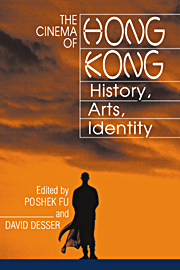Book contents
- Frontmatter
- Contents
- List of Contributors
- Acknowledgments
- Introduction
- Chronology of Hong Kong Cinema
- PART I HISTORY
- PART II ARTS
- PART III IDENTITY
- 9 Between Nationalism and Colonialism: Mainland Émigrés, Marginal Culture, and Hong Kong Cinema 1937–1941
- 10 Urban Cinema and the Cultural Identity of Hong Kong
- 11 Rewriting History: Hong Kong Nostalgia Cinema and Its Social Practice
- 12 Filming Diaspora and Identity: Hong Kong and 1997
- 13 Buying American, Consuming Hong Kong: Cultural Commerce, Fantasies of Identity, and the Cinema
- 14 Hong Kong Electric Shadows: A Selected Bibliography of Studies in English
- Index
9 - Between Nationalism and Colonialism: Mainland Émigrés, Marginal Culture, and Hong Kong Cinema 1937–1941
Published online by Cambridge University Press: 05 June 2012
- Frontmatter
- Contents
- List of Contributors
- Acknowledgments
- Introduction
- Chronology of Hong Kong Cinema
- PART I HISTORY
- PART II ARTS
- PART III IDENTITY
- 9 Between Nationalism and Colonialism: Mainland Émigrés, Marginal Culture, and Hong Kong Cinema 1937–1941
- 10 Urban Cinema and the Cultural Identity of Hong Kong
- 11 Rewriting History: Hong Kong Nostalgia Cinema and Its Social Practice
- 12 Filming Diaspora and Identity: Hong Kong and 1997
- 13 Buying American, Consuming Hong Kong: Cultural Commerce, Fantasies of Identity, and the Cinema
- 14 Hong Kong Electric Shadows: A Selected Bibliography of Studies in English
- Index
Summary
Hong Kong has been marginal to twentieth-century Chinese culture. This marginality stems both from the fact that Hong Kong is situated at the fringe of China's geopolity and from a popular stereotype of the city as a “cultural desert.” This imagery began to circulate around the 1920s among some mainland intellectuals seeking refuge in the British colony who, as the children of the May Fourth Enlightenment, were ill at ease not only with the “exotic” local dialect but with what they considered its hybridized culture: simultaneously Westernized, feudal, colonial, and provincial. Westernized as it appeared, Hong Kong had never experienced a cultural revolution comparable to the May Fourth Movement and its cultural discourse controlled by colonizers, taipans, compradors, and Confucian moralists. To many mainlanders it was a desert at the periphery of Chinese culture where no progressive, diverse modes of cultural practice could possibly exist. This stereotypical representation has until recently dominated both the popular and scholarly imagery of Hong Kong.
The colony's cinema, its major mass cultural product, has also been largely ignored by China scholars. Movies “made in Hong Kong” were perceived as merely “made for money”: box-office driven, frivolous, devoid of artistic and social meaning. One of the early critics was Shanghai modernist writer Mu Shiying, who, after a brief stint with the Cantonese cinema, ridiculed it as “the biggest joke in the world and the greatest humiliation of the human race.”
- Type
- Chapter
- Information
- The Cinema of Hong KongHistory, Arts, Identity, pp. 199 - 226Publisher: Cambridge University PressPrint publication year: 2000
- 6
- Cited by

